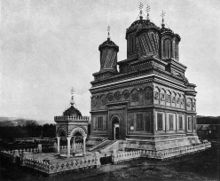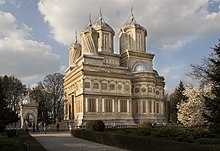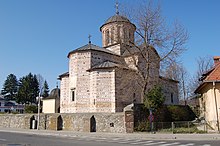Curtea de Argeș
| Curtea de Argeș | ||||
|
||||
| Basic data | ||||
|---|---|---|---|---|
| State : |
|
|||
| Historical region : | Great Wallachia | |||
| Circle : | Argeș | |||
| Coordinates : | 45 ° 8 ' N , 24 ° 41' E | |||
| Time zone : | EET ( UTC +2) | |||
| Height : | 450 m | |||
| Area : | 75 km² | |||
| Residents : | 27,359 (October 20, 2011) | |||
| Population density : | 365 inhabitants per km² | |||
| Postal code : | 115300 | |||
| Telephone code : | (+40) 02 48 | |||
| License plate : | AG | |||
| Structure and administration (as of 2016) | ||||
| Community type : | Municipality | |||
| Structure : | 1 District / cadastral municipality: Noapteș | |||
| Mayor : | Constantin Panțurescu ( PSD ) | |||
| Postal address : | B-dul Basarabilor, No. 99 loc. Curtea de Argeș, jud. Arges, RO-115300 |
|||
| Website : | ||||
Curtea de Argeş [ ˌkurte̯a de ˈard͡ʒeʃ ] ( , German Argish ) is a Romanian city in the Argeş district . It is located on the right bank of the Argeș River , which flows here through a valley in the Southern Carpathians .
population
| 1900 | 1912 | 1930 | 1956 | 1966 | 1977 | 1992 | 2002 | 2008 | 2011 |
|---|---|---|---|---|---|---|---|---|---|
| 4210 | 6279 | 6809 | 10,746 | 16,424 | 24,645 | 35,824 | 32,510 | 33,243 | 27,359 |
history
Curtea de Argeș is one of the oldest cities in Romania. According to tradition, it was founded in the 14th century by Prince Radu Negru , who subsequently named it the first capital of the Principality of Wallachia . That is why it was given the name Curtea (dt. Court ). There are several historical church buildings in the city. At the end of the 18th century a bishopric was built.
coat of arms
Blazon : "In gold a soaring, left-looking, red-armored, gray eagle with a left-turned golden sword in a gold-tipped red scabbard in the claws and a golden toe-tip cross in the beak." a growing black eagle with a cross in its beak and black windows in two rows. "
Art monuments and sights
cathedral
The Curtea de Argeş Cathedral (Mănăstirea Curtea de Argeş, Catedrala Curtea de Argeş) is one of the most famous buildings in Romania. It stands on the foundations of a monastery and is about one and a half kilometers north of the city. It resembles a very large and ornate mausoleum and was built in the Byzantine style with Moorish arabesques .
Its floor plan is rectangular, but there are many additions to the rear. A dome rises in the center of the building, two smaller domed towers on the front side, while a second dome, wider and higher than the central one, rises from the annex. An inverted, pear-shaped stone sits enthroned on each tip. It symbolizes a triple cross that represents the Trinity .
The cathedral is also the burial place of the Romanian royal family. The following members of the family were buried here:
|
There is a large royal palace in the Moorish style near the cathedral. The inventory of the cathedral was looted by Hungarians and Turks , but some inscriptions by the Greeks , Slavs and Romanians have been preserved.
A stone tablet says that Prince Neagoe Basarab built the cathedral from 1512 to 1521. Another reports that Prince Ioan Radu completed the work in 1526. A third description from 1681 tells of repairs carried out by Prince Șerban I. Cantacuzino . The fourth panel documents a restoration by the first bishop Joseph in 1804. Between 1875 and 1885 the cathedral was reconstructed and in 1886 it was restored.
More art monuments
- Princely Church "Saint Nicholas of Curtea de Argeș" (Biserica Domnească "Sfântul Nicolae din Curtea de Argeș")
- Church "Saint Nicholas the Little" (Biserica "Sân Nicoară" or Biserica "Sfântul Nicolae cel Mic")
traffic
Curtea de Argeş is located on the railway line that runs from Piteşti over the Rotenturm Pass .
Legends
The legends have inspired many Romanian poets, including award-winning artist Vasile Alecsandri . One story describes how Neagoe Basarab , while in captivity in Constantinople , designed a great mosque for the Sultan and then built the cathedral with the leftover material on his return.
Another version describes that Radu Negru employed an architect Meșterul Manole (Master Manole) or Manoli. Manole failed to complete the walls, so the prince threatened him and his assistant with death. Finally, according to an ancient Roman custom, Manole suggested that a living woman "work" into the foundations and that the one who would appear first the following morning should be walled in. The other stonemasons then warned their families, and Manole was forced to sacrifice his own wife. Then the cathedral could be completed. When Manole and his stonemasons reported to the prince that they could even build a larger building, Radu Negru set them on the roof so that they could no longer accomplish anything. They then constructed wooden wings to fly down from the roof. But one by one they crashed. A source of clear water was named after Manole because legend has it that it crashed at this point.
sons and daughters of the town
- Dincă Brătianu (1788–1844), Wallachian boyar
- Gabriel Matei (* 1990), Romanian football player
Web links
Individual evidence
- ↑ 2011 census in Romania ( MS Excel ; 1.3 MB)
- ^ Johann Christian von Engel: General World History , Johann Jacob Gebauer, Halle, 1804. Online at Google Books
- ^ Curtea de Argeș, 1930 census
- ↑ a b Curtea de Argeș, census at citypopulation.de
- ↑ Înmormântarea Reginei Ana sa încheiat , Adevărul August 13, 2016
- ↑ Ziua despărţirii de Regele Mihai , Adevărul December 16, 2017





